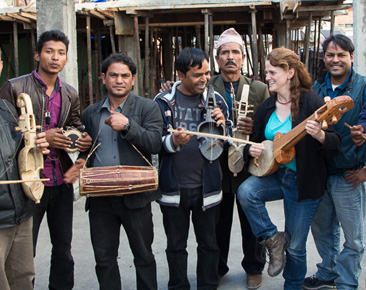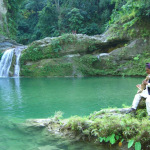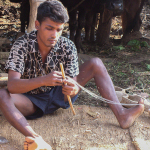
 Our occasional correspondent Tara Linhardt is spending several months again this year in her adopted second homeland of Nepal. She shared these thoughts from afar about the cultural traditions of native Nepalese music, how they are changing in our more interconnected world, and the parallels she sees in the changing traditions of American mountain music forms.
Our occasional correspondent Tara Linhardt is spending several months again this year in her adopted second homeland of Nepal. She shared these thoughts from afar about the cultural traditions of native Nepalese music, how they are changing in our more interconnected world, and the parallels she sees in the changing traditions of American mountain music forms.
Bluegrass and old time music in the US is such a wonderful thing. Part of the charm is in the irresistible sound of the traditional string instruments, but another is belonging to a really cool culture where we can’t help but have loads of jams, festivals, etc to share our music, our instruments, our stories – and partying down sometimes too – all coming from the rich cultural history which has brought our music to where it is today.
 Much like the way old time music grew into bluegrass and country, Nepali’s Gandharba musicians are in an exciting time of expanding and exploring where their old traditional mountain music can go. For centuries (or longer) the musician caste called the Gandharbas have been needed to provide live music for all sorts of ceremonies and events, and for times of fun and dancing. Now, in a quickly modernizing Nepal, suddenly they are competing against CDs, DVDs, radio, DJ’s, rock music and such. The old styles and songs have been preserved over so many years by being handed down person to person through the generations, but it is no longer grabbing and captivating the younger crowds, and is now possibly in danger of being lost.
Much like the way old time music grew into bluegrass and country, Nepali’s Gandharba musicians are in an exciting time of expanding and exploring where their old traditional mountain music can go. For centuries (or longer) the musician caste called the Gandharbas have been needed to provide live music for all sorts of ceremonies and events, and for times of fun and dancing. Now, in a quickly modernizing Nepal, suddenly they are competing against CDs, DVDs, radio, DJ’s, rock music and such. The old styles and songs have been preserved over so many years by being handed down person to person through the generations, but it is no longer grabbing and captivating the younger crowds, and is now possibly in danger of being lost.
What is really cool to a bluegrass or old time musician from the US is that some of the same types of things are happening here in Nepal that happened in the birth and growth of bluegrass from its old time roots. Traditionally all the Gandharbas make their own fiddles out of one piece of wood, and use cross-tuned gut strings giving a rich fullness to the sound, especially nice when one might be the whole band with one fiddle and a vocal just like our US traditions coming out of the Appalachian mountains.
 They now have people in Nepal who have started exploring how to take their old traditional fiddles (called sarangis) keep the basic design and tradition, but experiment with different woods and different angles, sizes and strings to try to get more volume and tone. Some have also been experimenting with different tunings to expand the possible fingerings, and play a greater variety of musical styles with their instruments. Musicians are also starting to bring in more and more improvisation, much like the way bluegrass grew out of the old time tunes and songs which stayed closer to the melodies. Now even some of them have put a pick up under the bridge and plug in to more easily play in this variety of musical styles on larger stages.
They now have people in Nepal who have started exploring how to take their old traditional fiddles (called sarangis) keep the basic design and tradition, but experiment with different woods and different angles, sizes and strings to try to get more volume and tone. Some have also been experimenting with different tunings to expand the possible fingerings, and play a greater variety of musical styles with their instruments. Musicians are also starting to bring in more and more improvisation, much like the way bluegrass grew out of the old time tunes and songs which stayed closer to the melodies. Now even some of them have put a pick up under the bridge and plug in to more easily play in this variety of musical styles on larger stages.
Although many people are on board exploring these new ideas, musicians like Shyam Nepali and his family (and his brothers’ band Kutumba) have been a leading force here in Nepal in exploring new ideas and options, as well as in archiving and preserving the old masters and tunes.
This clip of me and Shyam at his house, where he is surrounded by some of his beautiful varieties of sarangi ranging from brand new with new innovative designs to some that are 100 years old, shows how the American and Nepalese mountain music can mix. I know many a bluegrass musician that can relate to the joy in sharing their instrument collections with other musicians.
 For anyone interested in the roots of Appalachian music, seeing a Gandharba (musician caste) village is really cool. People in the village have all grown up in the music, making their own sarangi and tuners out of nearby trees. They pull bark off of pine trees to get their own rosin. Some people still know how to make the old gut strings the way it has been done for generations, but the scary thing is that not enough has really been done yet to archive and collect the old ways. As modernization is coming to Nepal at an amazing speed, many are worried about the how many of the old songs and traditions might be lost.
For anyone interested in the roots of Appalachian music, seeing a Gandharba (musician caste) village is really cool. People in the village have all grown up in the music, making their own sarangi and tuners out of nearby trees. They pull bark off of pine trees to get their own rosin. Some people still know how to make the old gut strings the way it has been done for generations, but the scary thing is that not enough has really been done yet to archive and collect the old ways. As modernization is coming to Nepal at an amazing speed, many are worried about the how many of the old songs and traditions might be lost.
Ram Prasad Kadel and the Music Museum of Nepal have been working as fast as they can for the last 18 years to record as many of the old masters as they can for their archives. As Ram explains it, preserving some of the great old traditions and ways Nepal is in its 11th hour, so he works as hard as he can to save these jewels for future generations. But with little money and resources, his museum is still quite humble and small, though beautiful and very well presented.
Now what is really fun is that since The Mountain Music Project made a documentary film a few years ago on how similar Appalachian old time music is to the Gandharba music here in the Nepali Himalaya, they have discovered that this other cousin of traditional music has been kept alive in the US as well. Our musics sound similar; scales, and themes are similar. On the Mountain Music Project CD, some of the great musicians like Tim O’Brien, Tony Triscka, Riley Baugus, Curtis Burch and many other extremely knowledgeable pickers were blown away by how similar out musics really sound.
 The Gandharba music community here would love to connect more to the old time and bluegrass worlds of the US. They have asked me to let the musicians, scholars, archivists, and fans of Appalachian style music to come on over and meet them and jam together. They can show you their traditional instruments and ways, and share with you yours. It is like going to a distant family reunion and discovering you have a cousin who is just so much fun and loves to do many of the same things you do, that you never knew you had.
The Gandharba music community here would love to connect more to the old time and bluegrass worlds of the US. They have asked me to let the musicians, scholars, archivists, and fans of Appalachian style music to come on over and meet them and jam together. They can show you their traditional instruments and ways, and share with you yours. It is like going to a distant family reunion and discovering you have a cousin who is just so much fun and loves to do many of the same things you do, that you never knew you had.


















